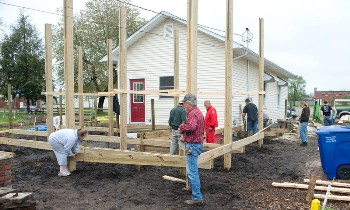Apr 30 2013
Several Indiana State University students and faculty joined some local gardeners to trudge through mud and dodge a few lingering raindrops Sunday to work on the latest addition to the grounds of the ISU Community Garden.
 Indiana State university students and faculty join local gardeners April 28, 2013 in building a deck outside the university's Sustainability House, located on the grounds of the Terre Haute Community Garden at 11th and Chestnut streets. The deck will feature a covered 40-person classroom on the back side of the house. (ISU/Tony Campbell)
Indiana State university students and faculty join local gardeners April 28, 2013 in building a deck outside the university's Sustainability House, located on the grounds of the Terre Haute Community Garden at 11th and Chestnut streets. The deck will feature a covered 40-person classroom on the back side of the house. (ISU/Tony Campbell)
They joined forces to help construct a deck outside the offices of the Institute for Community Sustainability, which is located on the grounds of the university-owned garden at 11th and Chestnut streets.
The 1,700-square-foot deck will feature such sustainable features as composite flooring containing 97 percent recycled plastic and a butterfly roof to capture rain water to use for irrigation.
The site located just a few blocks east of the Indiana State campus is intended to serve as an educational area but the 800-square-foot house in which the institute's offices are located does not provide much space for teaching, said Jim Speer, professor of geography and geology and executive director of the institute.
"The main feature of this project will be a covered 40-person teaching deck so we will be able to have classes and teach outdoors no matter what the conditions," Speer said. "We will also have space where we can do more outside and work with the gardeners so we're really taking our office outside."
Kara Phelps, a junior biology major took part in the deck build as part of Speer's conservation and sustainability class.
"I absolutely love the idea of a community garden and most of the gardeners try to be as sustainable and organic in what they do as possible," she said. "The idea of making the house that everyone uses as sustainable as we can is a great idea."
Joey Pettit, a doctoral student in earth and environmental systems helped with the project earlier in the week by helping to set support posts for the deck using an old-fashioned post-hole digger.
"I got to get my hands dirty again. That's not something I get to do very often in the lab," Pettit said. "I usually sit at a microscope or a computer for long periods at a time so for me it's getting fresh air and hanging out outside with a new set of people."
Ed White of White's Creative Landscaping, the contractor on the project, praised the work of Indiana State's students.
"They've been good to work with. They've done everything we need them to do. They dive right in there and help us," he said.
"This is going to vastly improve our garden site and made it look really snazzy," said Patti Weaver, manager of the Community Garden. "The deck is going to get to be used by the gardeners for a place to rest as well as for Jim's classrooms. I'm excited so I'm here to help."
About 80 gardeners now have plots on the site, which is in its sixth year as a community garden. Weaver said the gardeners are fortunate because the university provides all of the major work at the site and the city of Terre Haute supplies woodchips, greatly reducing the cost.
"Growing your own food and sustainability run hand in hand," Weaver said. "With the gardeners, I try to help them be more sustainable in their growing practices and in water usage. Having the sustainability people in the house with us is a real nice combo.
Lilly Endowment funds administered by Indiana State's Center for Community Engagement are funding construction of the deck as well as seven passive solar greenhouses and a shed for the garden, so equipment will no longer be stored inside the house, Speer said.
Indiana State, Ivy Tech Community College-Wabash Valley, Rose-Hulman Institute of Technology and Saint Mary-of-the-Woods College - and "hopefully some K-12 schools and the ISU Early Childhood Education Center" - will use the greenhouses, he said.
"Each greenhouse will be an experiment of its own," Speer said. "We're looking at possibly doubling the carbon dioxide level in our greenhouse to see how produce grows in that condition."